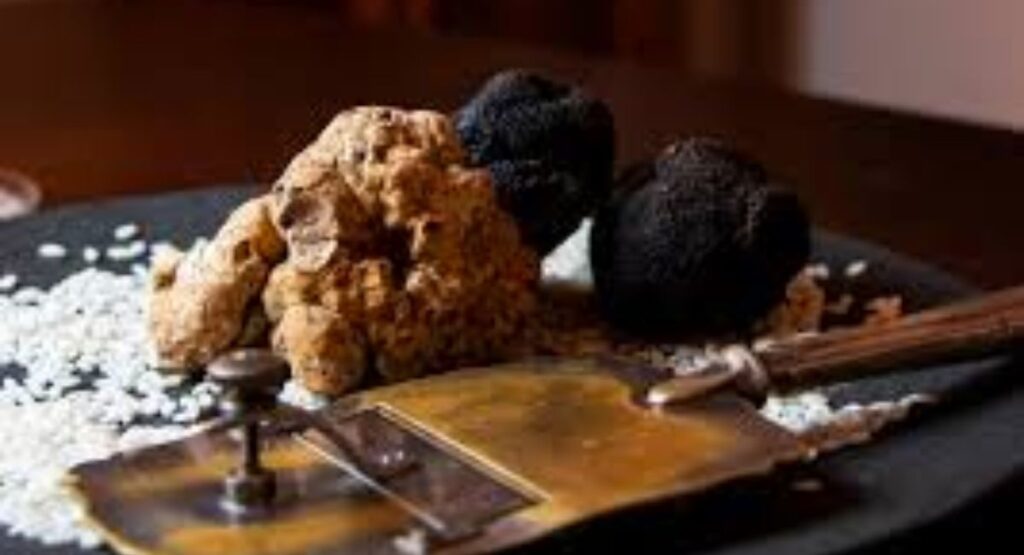
A rare few in the culinary world inspire fascination, luxury, and mystery: black truffles. The “diamonds of the kitchen,” these obscure fungi are known for their earthy aroma and fine black truffles flavor-having always enjoyed status as a delicacy. From Michelin-starred chefs in Paris to foodies in New York and Tokyo, there is a consensus across the world about black truffles being a marker of superior cuisine.
But what really makes black truffles so special? Why do they sell so dear? And in what sort of dishes can one use these truffles in daily life? In this comprehensive black truffle manual, owing to black truffle history, cultivation, varieties, culinary uses, health benefits, buying tips, and much more, will be thoroughly covered.
Whether you are a food lover, a chef, or just simply fascinated by this rare ingredient, this article will unfold all that there is to know about black truffles.
What Are Black Truffles?
Black truffles are a type of edible fungus that grows underground, typically near the roots of specific trees like oak, hazelnut, and beech. Unlike mushrooms that grow above the surface, truffles develop in a symbiotic relationship with tree roots, absorbing nutrients and minerals from the soil while providing benefits to their host trees.
The most famous black truffle species is the Tuber melanosporum, commonly known as the Périgord black truffle, named after the Périgord region in France where it thrives. These truffles are prized for their deep, musky aroma and complex taste that blends earthy, nutty, and slightly sweet notes.
Other notable varieties include:
- Summer Black Truffle (Tuber aestivum) – milder in flavor and more widely available.
- Burgundy Truffle (Tuber uncinatum) – harvested in autumn, slightly stronger than summer truffles.
- Chinese Black Truffle (Tuber indicum) – less aromatic, often considered an inferior substitute.
The History and Cultural Significance of Black Truffles
The history of black truffles stretches back thousands of years. Ancient civilizations like the Greeks and Romans valued truffles not only for their flavor but also for their supposed medicinal and aphrodisiac qualities. Roman philosopher Pliny the Elder once described truffles as a marvel of nature, while famed gourmets of the Renaissance praised them as divine.
By the 18th and 19th centuries, France became the epicenter of truffle culture. Aristocrats and royalty would host lavish truffle feasts, and chefs began incorporating black truffles into haute cuisine. Over time, truffles gained a reputation as the pinnacle of gastronomy—rare, mysterious, and undeniably luxurious.
Today, truffles remain a symbol of indulgence. The global market sees millions spent each year on black truffles, with auctions sometimes fetching thousands of dollars per kilogram. Their reputation as a luxury food item has only grown in the modern era of fine dining.
Where Do Black Truffles Grow?
The natural habitat of black truffles includes parts of France, Italy, and Spain, where the soil and climate create the perfect growing conditions. The Périgord region in France and Umbria in Italy are especially famous for producing some of the finest truffles in the world.
Truffle cultivation, known as “trufficulture,” has expanded globally, with countries like Australia and the United States now producing significant harvests. Farmers inoculate oak or hazelnut saplings with truffle spores and cultivate them over several years. Even with modern techniques, truffle farming is unpredictable, and not every tree will yield results.
The difficulty of cultivation, coupled with limited natural habitats, is one of the key reasons why black truffles are so expensive.
The Unique Flavor and Aroma of Black Truffles

One of the most intriguing qualities of black truffles is their aroma—a complex mix of earthy, nutty, and slightly garlicky scents that intensify when shaved or cooked. Scientists attribute this to volatile organic compounds, particularly sulfur-based molecules, that interact with our olfactory system in unique ways.
Flavor-wise, black truffles are less overwhelming than white truffles, offering a subtler yet deeply savory profile. They add depth and umami to dishes, enhancing the overall experience without overpowering other ingredients.
Common tasting notes of black truffles include:
- Earthy richness
- Slight nuttiness
- A hint of sweetness
- Subtle garlic undertones
This combination makes them versatile in both classic and modern cuisine.
How Black Truffles Are Harvested
Harvesting black truffles is a delicate process. Because they grow underground, humans rely on trained animals—traditionally pigs, but more commonly dogs today—to sniff out ripe truffles. Dogs are preferred since pigs have a tendency to eat the truffles once they find them.
Once located, truffle hunters carefully dig around the soil to extract the truffle without damaging it. The harvesting season typically runs from November to March for Périgord truffles, though it varies depending on the variety and region.
This labor-intensive and unpredictable process contributes to the rarity and cost of black truffles.
Culinary Uses of Black Truffles
Classic Dishes
Black truffles have long been a staple in French and Italian cuisine. Traditional dishes include:
- Truffle pasta – simple fresh pasta tossed with butter, Parmesan, and shaved truffles.
- Truffle risotto – creamy rice infused with truffle flavor.
- Truffle omelets – a rustic yet luxurious preparation highlighting truffle aroma.
- Truffle sauces – used to elevate meats, poultry, or fish.
Modern Applications
Today, chefs experiment with black truffles in innovative ways:
- Infused oils and butters
- Gourmet pizzas
- Truffle aioli for burgers or fries
- Truffle-topped sushi
The key is moderation—too much truffle can overwhelm a dish, while the right balance creates magic.
Health Benefits of Black Truffles
Beyond their gourmet appeal, black truffles also offer health benefits. They are low in calories, fat-free, and rich in essential nutrients.
Nutritional highlights include:
- Antioxidants – protect against free radical damage.
- Protein – higher than most other fungi.
- Minerals – including calcium, magnesium, and iron.
- Dietary fiber – supports digestion.
Some studies suggest truffles may also have antimicrobial properties, potentially supporting immune health. While they’re not a “superfood” in the trendy sense, they certainly provide more than just flavor.
Why Are Black Truffles So Expensive?
Several factors explain the high cost of black truffles:
- Scarcity – they only grow under specific conditions.
- Labor-intensive harvesting – requiring trained animals and careful handling.
- Unpredictability – not all truffle farms succeed, even after years of cultivation.
- High demand – top restaurants and gourmets compete for limited supply.
Prices can range from hundreds to thousands of dollars per pound, depending on quality, season, and origin.
How to Buy and Store Black Truffles
If you’re considering buying black truffles, keep these tips in mind:
- Fresh vs. Preserved: Fresh truffles are best but have a short shelf life (about 1–2 weeks). Preserved options like truffle oil, butter, or paste last longer but vary in quality.
- Look for firmness: Fresh truffles should feel firm, not spongy.
- Aroma test: They should have a strong, pleasant scent—weak aroma may indicate poor quality.
- Storage: Wrap in paper towels, place in an airtight container, and store in the fridge. Change paper towels daily.
For longer preservation, some chefs freeze truffles, though this can diminish flavor intensity.
Black Truffle Products in Everyday Cooking
For those who can’t access fresh truffles regularly, there are plenty of black truffle products on the market:
- Truffle oil – drizzle over pasta, pizza, or salads.
- Truffle butter – spread on bread or melt into sauces.
- Truffle salt – sprinkle over popcorn, eggs, or steak.
- Truffle cheese – adds luxury to cheese boards and pasta.
While not a replacement for fresh truffles, these products make gourmet flavors more accessible.
Truffle Hunting Tourism: An Experience Like No Other
In recent years, truffle hunting has become a popular tourist activity. Regions like Tuscany, Périgord, and Catalonia offer guided hunts where participants join local experts and trained dogs in search of black truffles.
These tours provide not only the thrill of discovery but also cultural immersion, often ending with truffle-based feasts. For food travelers, it’s an unforgettable way to experience the magic of truffles firsthand.
Sustainability and the Future of Black Truffles
With rising demand and climate change threatening natural habitats, sustainability is a growing concern in the truffle industry. Researchers are exploring improved cultivation techniques, including inoculated seedlings and climate-adapted farming.
Supporting ethical truffle farms and avoiding counterfeit products (like synthetic truffle oils) helps ensure that future generations can continue to enjoy authentic black truffles.
Final Thoughts: The Timeless Allure of Black Truffles
From their mysterious growth underground to their unforgettable flavor on the plate, black truffles embody everything we love about gourmet cuisine—rarity, elegance, and indulgence. They connect us to centuries of culinary tradition while continuing to inspire new creations in kitchens worldwide.



